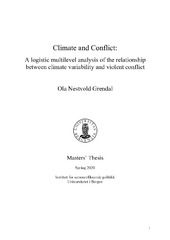Climate and Conflict: A logistic multilevel analysis of the relationship between climate variability and violent conflict
Master thesis
Permanent lenke
https://hdl.handle.net/1956/22931Utgivelsesdato
2020-06-24Metadata
Vis full innførselSamlinger
Sammendrag
In this thesis I investigate the link between climate variability and violent conflict. By applying an unconventional way of measuring conflict with regards to death toll based in contemporary climate-conflict literature, I investigate whether there exists a relationship between variations in climate measures and the occurrence of violent conflict. Building on contemporary theoretical assumptions where intermediate variables are seen as central, I build a theoretical argument where five categories of contextual variables are presented. These are cultural, economic, institutional, geographical and demographic. From these categories, I draw variables where I expect climate variability to have an intensifying effect on violent conflict. The hypotheses created from these theoretical categories are tested within a logistic multilevel regression-framework, and later by a mediation analysis. I utilize a detailed and nuanced sort of data from four different sources to test my theoretical claims. The datasets contain data on 49 African and Latin-American countries (N=15678), allowing for a broad analytical scope. Based on the analysis performed in this thesis, little support is provided for the supposed relationship. Using multiple alternative variables to measure variability in climate the results stay more or less the same. Few consistent links are found. However, one cannot yet confidently discard the existence of a relationship; It might be the case that statistical analyses struggle to identify the complex mechanisms and processes at play. Both geographic and temporal complexity is present. More detailed qualitative analyses should be performed in order to more concisely create specific theories. By exploring cases where the relationship is thought to be present one can perform in-debt analyses of the mechanisms and processes at play.
